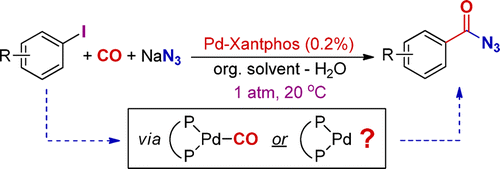Azidocarbonylation of iodoarenes with CO and NaN3, a novel Heck-type carbonylation reaction, readily occurs in an organic solvent-H2O biphasic system to furnish aroyl azides at room temperature and 1 atm. The reaction is catalyzed by Xantphos-Pd and exhibits high functional group tolerance. The catalyst deactivation product, [(Xantphos)PdI2], can be reduced in situ with PMHS to Pd(0) to regain catalytic activity. In this way, the catalyst loading has been lowered to 0.2% without any losses in selectivity at nearly 100% conversion to synthesize a series of aroyl azides in 80-90% isolated yield on a gram scale. Alternatively, the ArCON3 product can be used without isolation for further transformations in situ, e.g., to isocyanates, ureas, benzamides, and iminophosphoranes. A detailed experimental and computational study has identified two main reaction pathways for the reaction. For both routes, Ar-I oxidative addition to Pd(0) is the rate-determining step. In the presence of CO in excess, the Ar-I bond is activated by the less electron-rich Pd center of a mixed carbonyl phosphine complex. Under CO-deficient conditions, a slightly lower energy barrier pathway is followed that involves Ar-I oxidative addition to a more reactive carbonyl-free (Xantphos)Pd0 species. Mass transfer in the triphasic liquid-liquid-gas system employed for the reaction plays an important role in the competition between these two reaction channels, uniformly leading to a common aroyl azido intermediate that undergoes exceedingly facile ArCO-N3 reductive elimination. Safety aspects of the method have been investigated.
